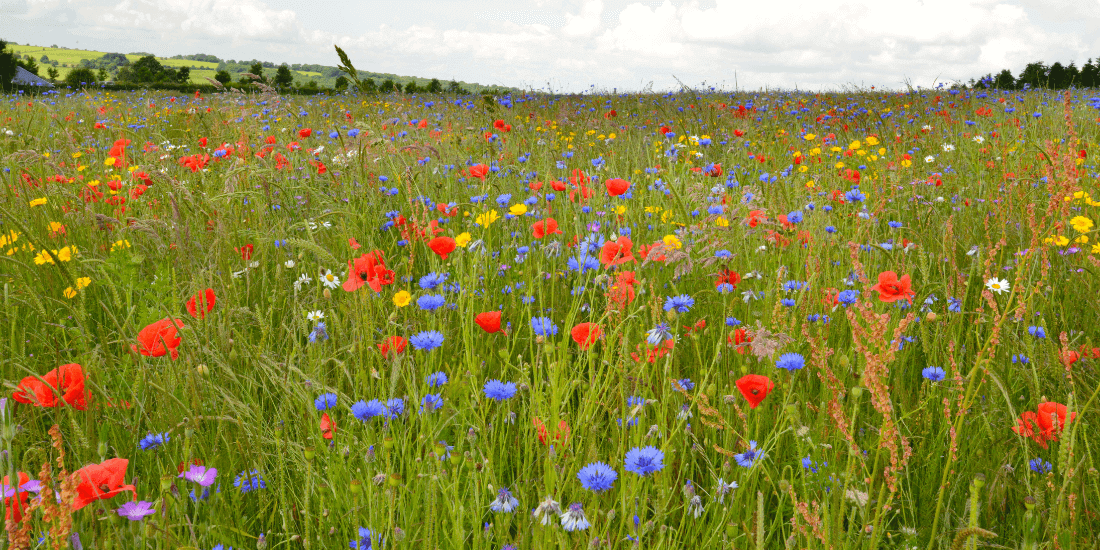When to sow wildflower seeds

Although they are known for being low maintenance and easy to manage, wildflowers require some attention to detail to prepare for sowing your seed. So, before you begin planting, you need to know when to sow wildflower seeds to achieve the best results from growing wildflowers in the UK.
Advice for when to sow wildflower seeds
Spring and autumn are typically the best times of the year to sow your wildflower seeds, depending on when you want to see them bloom. So keep reading to discover the best times of the year for when to sow wildflower seeds.
Sowing wildflower seeds in spring
Once the spring sunshine peaks its head through the clouds, it can be hard to resist heading out into your gardens to kickstart the sowing season! Sowing your wildflower seeds in early spring (March) will mean you miss out on an April bloom, but it also has its advantages!
Benefits of planting wildflowers in spring
During spring, the temperatures are improving, and rain showers will most definitely grace your gardens quite frequently. These combined will create ideal germination conditions for your seeds to grow in. You can expect to see your wildflowers bloom between 60-90 days after sowing. When summer comes around, your garden will be filled with colour, interesting shapes, sweet smells and wildlife activity!
Sowing wildflower seeds in autumn
Autumn is often overlooked as an excellent time to sow wildflower seeds, but it’s probably one of the most beneficial times to sow your wildflower seeds.
Remember that wildflower seeds need light, warmth and rain for successful germination. And all of which is typical of an early autumn day. This means there is extra moisture in the air to be absorbed by the seeds, and it also means less watering for you to do as nature takes its course!
Benefits of planting wildflower in autumn
If you choose to sow in autumn, you will normally see your wildflowers beginning in the early springtime, guaranteeing a full and colourful bloom for those summer evenings in the sun. It’s also worth mentioning that the number of pests and birds will also decrease quite rapidly during autumn, so your seeds will have less damage and stress to contend with.
How to sow your wildflower seeds
Like most things, preparation is key! And that is no different for wildflowers. Creating the perfect seedbed free from debris, weeds, or flora is crucial to your wildflower’s success. Our guide on how to sow your wildflower seeds goes through each step, and if followed correctly, you will no doubt see a beautiful display of wildflower blooms soon after sowing!
Do wildflowers grow back every year?
The answer to this question is yes and no because it depends on the type of wildflowers you have planted. Perennial wildflowers will grow back year after year for many years but take longer to establish. Whereas annual wildflowers appear 60-80 days after sowing but typically will bloom for one season only.
You can encourage annuals to return the following year by seed saving. Annuals do this themselves to some degree, but you will see a better return if you lend them a helping hand! You can assist in this process by collecting the seed heads, splitting them up, and opening them, allowing more seeds to scatter across your garden. This will result in a full showing of annual wildflowers the following season.
Choosing a wildflower seed mix to sow
Before choosing a wildflower mix, you need to know which wildflower mix to sow to enhance the look of your UK wildflower meadow. It’s best to understand what each of our wildflower seed mixes is for; this way, you can find the best seed for your needs, soil types and chosen locations. We have a range of ten different wildflower seed mixes, each carefully created and tailored to specific soil types and locations. So, if your garden suffers from clay soils, shaded spots or if you are trying to attract more bees and butterflies – one of our wildflower seed mixes will match your needs!
For further reading, we have a helpful guide on how to manage your wildflower garden.
For more tips and tricks on sowing, growing, and maintaining your wildflower garden, head over to our wildflower help and advice page and our Wildflowers Frequently Asked Questions section.